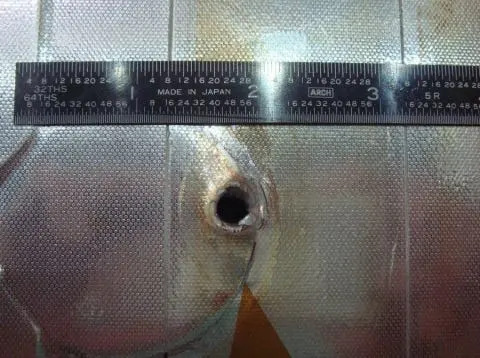Julian Borger in New York
Fri, March 1, 2024

Palestinian people queue for food distributed by a charity in Deir al Balah, central Gaza. Allegations against 12 employees led major donors to suspend funding to UNRWA.Photograph: Anadolu/Getty Images
A month after Israeli allegations that a dozen United Nations staff were involved in the 7 October Hamas attack, UN investigators have yet to receive any evidence from Israel to support the claims, though they expect some material to be forthcoming “shortly”.
The allegations against the 12 employees of the UN Relief and Works Agency for Palestine (UNRWA) led 16 major donors to suspend contributions totalling $450m at a time when more than 2 million Gazans are facing famine. UNRWA says it is approaching “breaking point” and only has sufficient funds to continue functioning for the next month at most.
The UN Office of Internal Oversight Services (OIOS) launched an investigation on 29 January in the wake of the Israeli allegations initially presented to UNRWA in January, and delivered an update on its work to the UN secretary general, António Guterres, on Wednesday.
Related: Israel is deliberately starving Palestinians, UN rights expert says
Diplomats who saw the OIOS preliminary report said it contained no new evidence from Israel since the initial presentation of the claims in January – which were not backed by any proof. In summarising the findings, the UN spokesperson, Stéphane Dujarric, confirmed that the investigation had yet to receive corroborating material from Israel.
“OIOS investigators have reviewed the initial information received by UNRWA from Israeli authorities,” Dujarric said on Thursday. “The investigation remains ongoing. OIOS will seek to corroborate additional information and to compare the information obtained with materials held by Israeli authorities, which OIOS expects to receive shortly.
“OIOS staff are planning to visit Israel soon to obtain information from Israeli authorities that may be relevant to the investigation,” Dujarric said, adding that the investigators had described member state cooperation as “adequate”.
He said that the investigators had consulted other member states and visited the UNRWA headquarters in Jordan to review information on UNRWA staff and operations, including electronic communications and data on the use of UN vehicles.
Following news of the OIOS report, the EU announced it would resume funding of UNRWA, with payment of €50m immediately to be followed by a further €32m once the investigation was completed and a range of reforms implemented.
The Wall Street Journal reported last week that an assessment by the US national intelligence council, assessed with “low confidence” that a handful of UNRWA staffers had participated in the 7 October attack on southern Israel, in which 1,200 people, mostly civilians, were killed.
The Israeli mission at the UN referred queries about the investigation to the foreign ministry in Tel Aviv. The foreign minister, Israel Katz, has said that the government would “give them all the materials that prove UNRWA’s involvement in terrorism and their damage to the future of the region”.
Since the initial allegations against 12 UNRWA workers, nine of whom are believed to be still alive, Israel has claimed that a total of 190 UNRWA employees, including teachers, have also been Hamas or Islamic Jihad militants. The Israeli military also said that a tunnel had been found under UNRWA’s headquarters in Gaza and that guns and ammunition had been found in the headquarters building.
The head of UNRWA, Philippe Lazzarini, said the agency “did not know what is under its headquarters in Gaza”, which he pointed out had been abandoned since an Israeli order to evacuate in October. He said that in times of relative peace, UNRWA inspected its premises every quarter, and always protested if its neutrality had been violated.
Israel has long called for UNRWA, established in 1949, to be dismantled, but with 30,000 staff, (13,000 in Gaza) it dwarfs every other UN agency, which have a combined total of about 200 employees in Gaza.
“It is a little bit shortsighted to believe that UNRWA can just technically hand over all its activities to other UN agencies or NGOs,” Lazzarini told journalists in Jerusalem on Thursday.
“It’s an agency [that’s] quite unique because we are … primarily providing government-like services to one of the most destitute communities in the region,” he said.
“The World Food Programme itself has said that it cannot stave off starvation which is already impacting hundreds of thousands of people,” Christopher Gunness, a former UNRWA spokesperson, said. “That can only be done by UNRWA, with its 13,000 workers, its warehouses and its food distribution centres.”
“The OIOS report is a ladder on which all the defunding donors can climb down if they wish to and avoid accusations of complicity in starvation and genocide, as well as bowing to the political agenda of Israel’s far right,” Gunness said.
Parallel to the OIOS inquiry, a broader review of UNRWA’s activities and neutrality is under way, led by a former French foreign minister, Catherine Colonna, and supported by three Nordic research organisations.
The Colonna review was commissioned by Guterres in January, before the Israeli allegations were made. It is expected to provide a progress report in mid-March, which could prompt a resumption of funding from major donors, before the agency runs out of money altogether, diplomats at the UN said. The review group is expected to deliver a final report in mid-April
European Commission to resume UNRWA funding as doubt cast on Israeli claims about staff involvement in Oct. 7 attack
Patrick Hilsman
Fri, March 1, 2024

The European Commision said Friday that it will resume funding for the UNRWA after reports cast doubt on Israeli government claims that employees had been involved in the Oct. 7 attacks. File Photo by Debbie Hill/UPI
March 1 (UPI) -- The European Union will resume funding for the United Nations Relief Works Agency as international agencies and media reports cast doubt on Israeli government claims that employees took part in the Oct. 7 attacks in Israel.
"Following the exchange of letters with UNRWA confirming its commitments, the commission will proceed disburse a first tranche of EUR 50 million out of the EUR 82 million foreseen for UNRWA for 2024," the European Commission said in a press release Friday.
In January, the Israeli government claimed 12 UNRWA employees were involved in the Oct. 7 attacks inside Israel.
The accusations prompted the U.S. government, as well as the governments of multiple contributing states, to halt aid to UNRWA, and the organization subsequently fired employees.
"We stand by the Palestinian people in Gaza and elsewhere in the region. Innocent Palestinians should not have to pay the price for the crimes of terrorist group Hamas," said European Commision President Ursula von der Leyen.
"They face terrible conditions putting their lives at risk because of lack of access to sufficient food and other basic needs. That is why we are reinforcing our support to them this year by a further EUR 68 million," von der Leyen said.
Earlier this month, UNRWA commissioner general Phillipe Lazzarini said the employees had been fired without evidence and that the claims were under investigation.
"If the investigation tells us that this was wrong, in that case at the U.N. we will take a decision for how to properly compensate them," Lazzarini said.
Multiple news reports, including from the Daily Beast and Britain's Channel 4, found that Israeli reports alleging UNRWA staff involvement in the Oct. 7 attacks were unsubstantiated.
According to the Wall Street Journal, the U.S. intelligence community assessed the claims as plausible with "low confidence."
Sources told the Wall Street Journal that a U.S. intelligence report contained passages referring to the potential of Israeli government bias affecting the validity of the claims.
The United Nations subsequently has cast doubt on the allegations, saying they were presented without evidence.
"UNRWA has not received any information, let alone any evidence, from the Israeli Authorities or any other member state about the ... claim," the UN said in a press release.
"The names of the 12 individuals against whom allegations were made were all shared multiple times with Israel and other member states," the United Nations said. "Prior to January 2024, UNRWA did not receive any indication from the relevant authorities of any involvement of its staff in armed or militant groups."
In February, U.N. Secretary General Antonio Guterres also reaffirmed his commitment to UNRWA, calling the organization "the backbone of all humanitarian response in Gaza."
According to Gaza's Ministry of Health, more than 30,000 people have been killed by the Israeli military since Oct. 7.
European Commission lifts suspension of €50 million in aid for UNWRA
DPA
Fri, March 1, 2024

Ursula von der Leyen, President of the European Commission, stands in the plenary chamber of the European Parliament and speaks. A central point of the debate was the EU's defense policy. Philipp von Ditfurth/dpa
The European Commission released suspended EU funding for the UN Relief and Works Agency for Palestinian Refugees in the Near East (UNRWA) worth €50 million ($54 million) on Friday.
"Innocent Palestinians should not have to pay the price for the crimes of terrorist group Hamas," European Commission President Ursula von der Leyen said in a statement.
The EU executive arm also announced a further €68 million in aid for the region to be distributed by the International Committee of Red Cross (ICRC) and other organizations.
The commission suspended the funding for UNRWA and demanded an independent audit of the agency after Israel accused about a dozen employees of being involved in the October 7 terrorist attacks led by the Palestinian militant group Hamas.
Based on commitments from UNRWA to carry out this investigation and to review safeguards to prevent staff's involvement in terrorist activities, the commission said it decided to release the €50 million in funding meant for the month of March.
A further two disbursements of EU aid, each worth €16 million, is to be released pending UNRWA's success in implementing the review, the commission said. Restored funding for UNRWA amounts to €82 million.
Another €125 million in aid has already been allocated to Palestinians for 2024 with the first sums distributed on Friday, the commission added.
In addition to the new funding announced worth €68 million, this brings the total amount of EU aid for the Palestiians for the year to €275 million.
European Commissioner Olivér Várhelyi, who pushed unsuccessfully to suspend aid in the immediate aftermath of the October 7 attacks, said the EU executive arm was "diversifying its assistance for the innocent Palestinian people in Gaza."
Várhelyi stressed that it was "essential that UNRWA delivers on the agreed measures and conditions for [the EU's] continued assistance."
This includes checking UNRWA staff for links to the October 7 attacks as well vetting staff during recruitment processes and on a continuous basis, he said.
Várhelyi said UNRWA was also to increase checks to protect assets from misuse.
As well as staff links to the October 7 attacks, the main UN aid agency for Palestinians in Gaza has been under heavy scrutiny after the Israeli military said it discovered a Hamas command tunnel running under UNRWA's headquarters.
Earlier von der Leyen said she was "deeply disturbed by images from Gaza" after Israeli soldiers opened fire on a crowd at an aid convoy.
"Every effort must be made to investigate what happened and ensure transparency," von der Leyen said on X, formerly Twitter.
EU to continue funding UNRWA as it probes alleged staff involvement in Oct 7 attacks
Mared Gwyn Jones
Fri, March 1, 2024

EU to continue funding UNRWA as it probes alleged staff involvement in Oct 7 attacks
The Commission confirmed on Friday morning that it will proceed with the €82 million payment foreseen for UNRWA in 2024, with a first €50-million tranche to be paid next week.
The executive will also pledge an additional €68 million in emergency support to Palestinians across the region, to be paid through international partners such as the Red Cross and the Red Crescent, as concerns mount over the Israeli offensive in the besieged Gaza Strip.
In late January, the Commission launched a review of its support to UNRWA after Israel accused a dozen staff members of involvement in Hamas’ October attacks, which killed over 1,200 Israelis and provoked a war in Gaza that has claimed the lives of some 30,000 Palestinians.
The bloc’s chief diplomat Josep Borrell and humanitarian aid commissioner Janez Lenarčič have both said that Israel is yet to provide evidence to back its allegations.
Some Western nations - including Australia, Austria, Canada, Germany, Italy, the Netherlands, the United Kingdom and the United States - decided to temporarily suspend aid in response to the accusations, dealing a devastating blow to the donor-reliant agency, which says its deliveries of humanitarian cargo have halved since January.
Other countries such as Spain, Ireland and Belgium, continued or increased their support.
The Commission's decision to proceed with payments was taken in light of the steps taken by UNRWA to audit its recruitment procedures, bolster its internal oversight mechanisms and vet its 30,000-strong workforce.
EU neighbourhood commissioner Olivér Várhelyi said that UNRWA's commitment to "introduce robust measures to prevent possible misconduct & minimize risk of allegations is welcome."
It is seen as a lifeline for the agency, which had warned it could shut down by the end of February unless donations resumed. It also puts pressure on other nations to review their decisions to withhold funding. Later on Friday, Belgium announced it was committing payments to UNRWA for 2024-2026, with development minister Caroline Gennez warning that "defunding means death sentence for 10,000s".
A Commission spokesperson said that discussions with UNRWA regarding the conditions in order to safeguard the flow of aid had continued until earlier on Friday.
The bloc's humanitarian aid to Palestinians - which amounts to €125 million in 2024 - continued unabated whilst the review was underway. Friday's announcement brings the EU's support to Palestinians to a total of €275 million this year.
Lenarčič commended the commitment of an additional €68 million in aid, warning that "thousands of lives are at stake."
A lifeline for UNRWA
The decision comes as the humanitarian crisis in Gaza deepens.
On Thursday, at least 112 were killed when the Israeli military opened fire on a crowd of hungry Palestinians, as an aid convoy moved in to Gaza City, in the north of the strip.
The massacre has been condemned by EU leaders, including Commission President Ursula von der Leyen.
The condemnation marks a turn of rhetoric for von der Leyen, who has throughout the conflict maintained a strong pro-Israeli stance.
European Council President Charles Michel also said on social media platform X that he was "shocked and repulsed" by the killing, adding that "international law does not allow for double standards."
The deadly attacks follow repeated warnings from UNRWA that the humanitarian situation in the north of the enclave has hindered the delivery of aid due to dangerous conditions.
In February, UNRWA chief Phillippe Lazzarini said in Brussels that UN agencies were unable to operate with the minimum required protection because many of the local police force had been killed or were reluctant to assist aid convoys due to fears for their safety.
The UN's World Food Programme (WFP) later announced it had decided to pause its deliveries to the north of Gaza "until conditions are in place that allow for safe distributions."
It means pockets of famine have appeared in the north, with the WFP's Famine Review Committee warning over 500,000, almost one in four of the population, could fall into famine by May.
Lazzarini has said that the exodus of donors has stripped UNRWA of $450 million (€418 million) this year alone, and that he is engaged with a number of countries to assess their expectations to allow the release of funds.
Borrell and other leading EU voices have consistently highlighted that UNRWA's work in Gaza is irreplaceable, and that to withdraw funding would have "dangerous repercussions on regional stability and would affect Europeans too."
Israeli Prime Minister Benjamin Netanyahu claims that UNRWA is "totally infiltrated" by Hamas and has called for the agency to be dismantled.





























